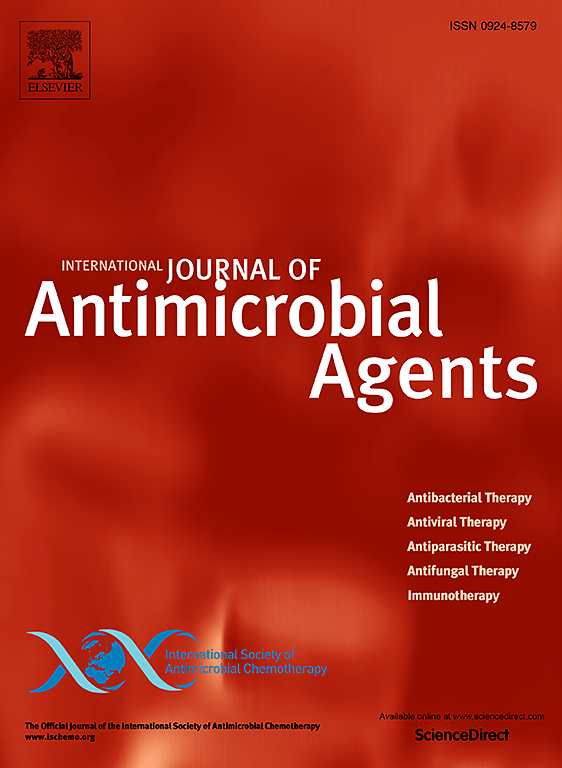Cefiderocol pharmacokinetics in critically-ill patients receiving extra-corporeal membrane oxygenation (ECMO)
IF 4.6
2区 医学
Q1 INFECTIOUS DISEASES
International Journal of Antimicrobial Agents
Pub Date : 2025-02-17
DOI:10.1016/j.ijantimicag.2025.107465
引用次数: 0
Abstract
Objective
Critical illness and organ support such as extracorporeal membrane oxygenation (ECMO) may influence antimicrobial pharmacokinetics. This study investigated cefiderocol pharmacokinetics in critically-ill patients receiving ECMO to understand if standard dosing achieves optimal exposure.
Methods
Cefiderocol was prescribed according to approved package insert recommendations based on creatinine clearance (CL). Blood sampling was performed at steady-state. Protein binding was determined by ultrafiltration. Concentrations were fitted using the non-parametric adaptive grid algorithm in Pmetrics for R. The fT > MIC for each patient was assessed at MICs of 4, 8, and 16 mg/L. Total AUC24h was calculated to evaluate comparative exposure to non-ECMO patients.
Results
Five patients receiving 1.5 g q8h to 2 g q6h dosing regimens were enrolled. Three patients received venous-arterial and two veno-venous ECMO (mean flow rate of 3.9 [range: 2.7–4.9] L/min). A two-compartment model fitted the data best with mean ± standard deviation estimates for CL, volume of the central compartment (V), K12, and K21 of 2.3 ± 0.5 L/h, 4.8 ± 2.3 L, 5.1 ± 2.8 h–1, and 3.9 ± 3.3 h–1, respectively. Mean protein binding was 41% (range: 31%–50%). Prescribed dosing regimens achieved 100% fT > MIC up to 16 mg/L for all patients, with a total steady-state AUC24h of 2501 (range: 1631–3276) mg/L·h.
Conclusions
These are the first data to describe cefiderocol pharmacokinetics in critically-ill patients undergoing ECMO. The currently labelled dosing recommendations based on creatinine CL in these patients were well tolerated and achieved 100% fT > MIC against susceptible bacteria and AUC exposures similar to values in non-ECMO patients.

头孢地罗在接受体外膜氧合(ECMO)的危重患者中的药代动力学。
目的:危重疾病和器官支持,如体外膜氧合(ECMO)可能会影响抗菌药物的药代动力学。本研究调查了头孢地罗在接受ECMO的危重患者中的药代动力学,以了解标准剂量是否达到最佳暴露。方法:根据批准的说明书建议,以肌酐清除率(CrCL)为基础开具头孢地罗处方。在稳态下采血。用超滤法测定蛋白结合。使用Pmetrics中的非参数自适应网格算法拟合r的浓度。在MIC为4、8和16 mg/L时评估每位患者的fT>MIC。计算总AUC24h以评估与非ecmo患者的比较暴露。结果:5例患者接受1.5g q8h ~ 2g q6h给药方案。3例患者接受静脉-动脉和2例静脉-静脉ECMO[平均流速3.9(范围:2.7-4.9)L/min]。两室模型最适合数据,间隙(CL)、中央室容积(V)、K12和K21的均值±标准差分别为2.3±0.5 L/h、4.8±2.3 L、5.1±2.8 h-1和3.9±3.3 h-1。平均蛋白结合率为41%(范围:31-50%)。所有患者的处方给药方案均达到100%的f> MIC,最高可达16mg /L,总稳态AUC24h为2501(范围:1631-3276)mg/L*h。结论:这是第一个描述头孢地罗在接受ECMO的危重患者中的药代动力学的数据。在这些患者中,目前基于CrCL的标签剂量建议耐受性良好,对易感细菌和AUC暴露达到100% fT>MIC,与非ecmo患者相似。
本文章由计算机程序翻译,如有差异,请以英文原文为准。
求助全文
约1分钟内获得全文
求助全文
来源期刊
CiteScore
21.60
自引率
0.90%
发文量
176
审稿时长
36 days
期刊介绍:
The International Journal of Antimicrobial Agents is a peer-reviewed publication offering comprehensive and current reference information on the physical, pharmacological, in vitro, and clinical properties of individual antimicrobial agents, covering antiviral, antiparasitic, antibacterial, and antifungal agents. The journal not only communicates new trends and developments through authoritative review articles but also addresses the critical issue of antimicrobial resistance, both in hospital and community settings. Published content includes solicited reviews by leading experts and high-quality original research papers in the specified fields.

 求助内容:
求助内容: 应助结果提醒方式:
应助结果提醒方式:


